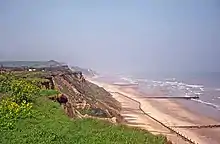| Site of Special Scientific Interest | |
 | |
| Location | Norfolk |
|---|---|
| Grid reference | TG 236 415[1] |
| Interest | Biological Geological |
| Area | 57.8 hectares (143 acres)[1] |
| Notification | 1992[1] |
| Location map | Magic Map |
Overstrand Cliffs is a 57.8-hectare (143-acre) biological and geological Site of Special Scientific Interest in Cromer in Norfolk.[1][2] It is a Special Area of Conservation[3] and part of it is a Geological Conservation Review site.[4][5]
These soft cliffs are subject to falls and slumping, providing a habitat for species associated with disturbance such as the rare beetles Bledius filipes, Harpalus vernalis and Nebria livida. The cliff is geologically important for its succession of Pleistocene glacial exposures.[6]
The beach is open to the public.
References
- 1 2 3 4 "Designated Sites View: Overstrand Cliffs". Sites of Special Scientific Interest. Natural England. Retrieved 13 June 2018.
- ↑ "Map of Overstrand Cliffs". Sites of Special Scientific Interest. Natural England. Retrieved 13 June 2018.
- ↑ "Designated Sites View: Overstrand Cliffs". Special Areas of Conservation. Natural England. Retrieved 1 June 2018.
- ↑ "Overstrand Cliff Section (Quaternary of East Anglia)". Geological Conservation Review. Joint Nature Conservation Committee. Retrieved 25 May 2018.
- ↑ "Overstrand to Trimingham Cliffs (Cenomanian, Turonian, Senonian, Maastrichtian)". Geological Conservation Review. Joint Nature Conservation Committee. Retrieved 25 May 2018.
- ↑ "Overstrand Cliffs citation" (PDF). Sites of Special Scientific Interest. Natural England. Retrieved 13 June 2018.
Wikimedia Commons has media related to Overstrand Cliffs.
This article is issued from Wikipedia. The text is licensed under Creative Commons - Attribution - Sharealike. Additional terms may apply for the media files.